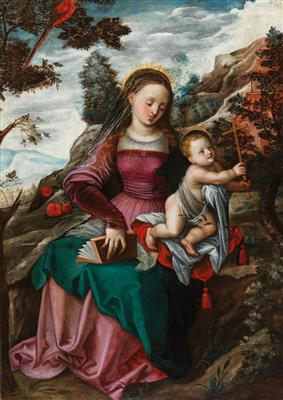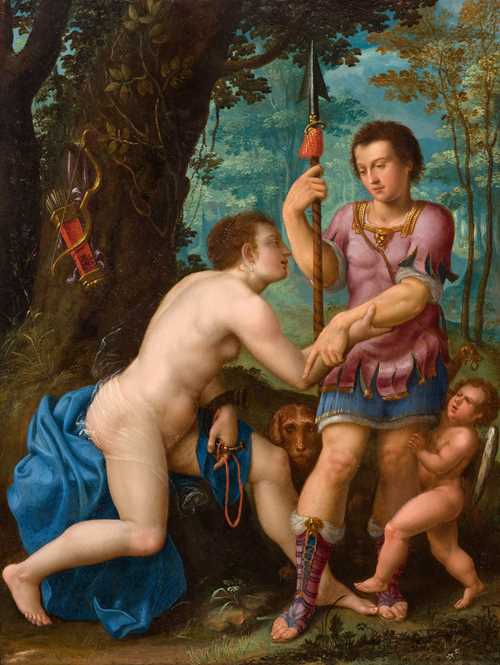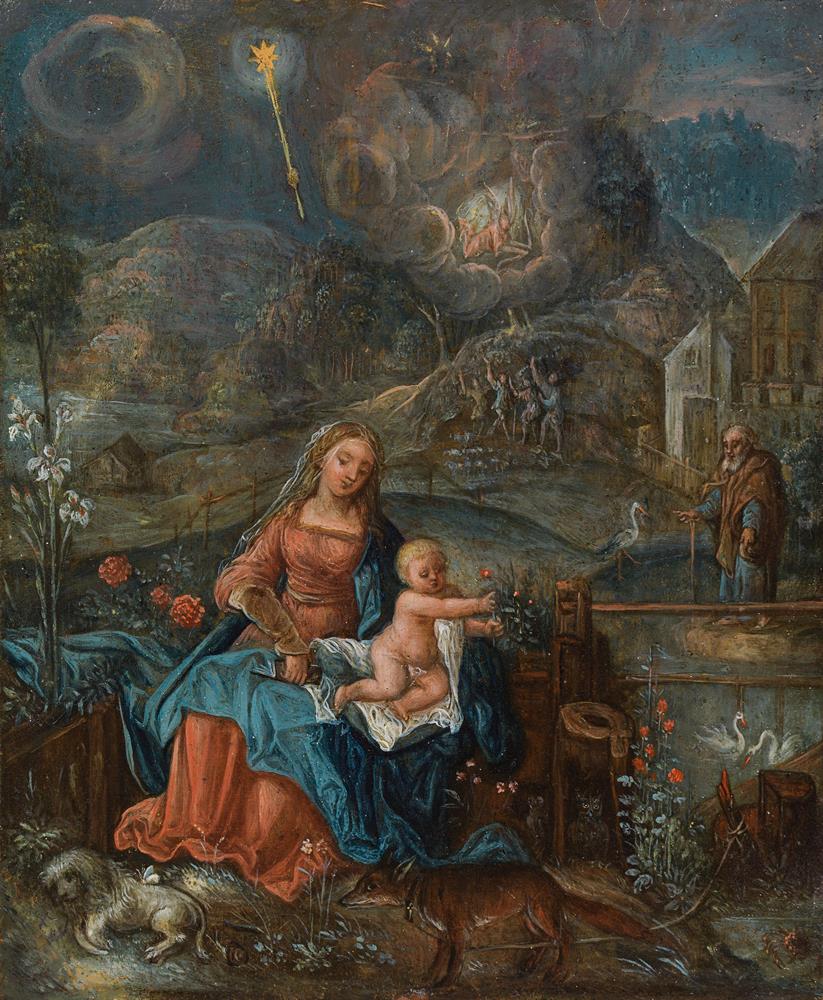(Augsburg 1573–1613 Prague) The Virgin and Child in a landscape, oil on canvas, 125.5 x 89.5 cm, framed Provenance: Convent of the Colettine Poor Clares, Bruges The attribution to Daniel Fröschl court painter to Emperor Rudolf II in Prague, has been endorsed by Rainer Stüwe, to whom we are grateful for his help in cataloguing the present lot. Stüwe’s extensive certificate accompanies the work, which he dates to the years around 1610. The motif of the present painting derives from the central motif of Albrecht Dürer’s Madonna of the Animals in the Albertina, Vienna, executed in 1503 as a watercoloured pen and ink drawing. Due to stylistic evidence this work must be seen in the context of the so-called ‘Dürer Renaissance’, a movement that emerged around 1600. It was the aim of the painter of the present work to reinterpret the figural composition in tune with the taste of the Dürer Renaissance in Prague by softening the expression of the scene. Different from the painted copies by Jan Brueghel the Elder at the Palazzo Doria in Rome and the engraving by Aegidius Sadeler the comprehensive narrative components of the prototype have been omitted from this modified composition so as to concentrate exclusively on its protagonists. On the other hand, the painter has added elements to the composition that seem unusual for its time, including a golden ferula in the hands of the Christ Child, whereas in the prototype the Infant Jesus is depicted without any attributes, pointing in the direction of a stork approaching the figure of Saint Joseph. The present painting shows numerous stylistic resemblances to works by Daniel Fröschl who was employed as antiquarian for the imperial art collections in Prague from 1607 onwards. Due to his function, Fröschl had access to Dürer’s prototypes, including the Madonna of the Animals, which had not yet been reproduced in the form of prints or other media. In addition, the artist seems to have had rudimentary knowledge of Far Eastern – probably Japanese – pagoda temples as early as around 1610, probably transmitted to Europe by way of rare written and amateurishly drawn accounts compiled by Jesuit missionaries during the second half of the sixteenth century. Moreover, he has modified Dürer’s model by changing the green parakeet at the lower left into a scarlet macaw, a large South American parrot, which around 1600 was only known to extremely privileged circles. The added motifs of a Japanese pagoda and a South American macaw suggest that the painter had access to specimens contained in a richly furnished chamber of curiosity and library from the period around 1600. According to contemporary sources and existing literature, which is scarce, Fröschl was mainly known for his exquisite miniatures based on sixteenth-century examples, supplied by artists like Dürer, Michelangelo, and Correggio. But both the present Madonna and a proportionally approximately live-sized picture of a Madonna sold at the Dorotheum, Vienna (23 October 2018, lot 6) and at Hejtmanek in Prague (28 May 2015, lot 34) make it clear that Fröschl, besides miniatures, also executed outstanding imitations of Dürer’s prototypes in larger dimensions. Fröschl trained in his native town of Augsburg. He later went to Florence, where he studied under Jacopo Ligozzi Then he worked for the Medici in Pisa and Florence until he was finally called to the court of Emperor Rudolf II in Prague.
(Augsburg 1573–1613 Prague) The Virgin and Child in a landscape, oil on canvas, 125.5 x 89.5 cm, framed Provenance: Convent of the Colettine Poor Clares, Bruges The attribution to Daniel Fröschl court painter to Emperor Rudolf II in Prague, has been endorsed by Rainer Stüwe, to whom we are grateful for his help in cataloguing the present lot. Stüwe’s extensive certificate accompanies the work, which he dates to the years around 1610. The motif of the present painting derives from the central motif of Albrecht Dürer’s Madonna of the Animals in the Albertina, Vienna, executed in 1503 as a watercoloured pen and ink drawing. Due to stylistic evidence this work must be seen in the context of the so-called ‘Dürer Renaissance’, a movement that emerged around 1600. It was the aim of the painter of the present work to reinterpret the figural composition in tune with the taste of the Dürer Renaissance in Prague by softening the expression of the scene. Different from the painted copies by Jan Brueghel the Elder at the Palazzo Doria in Rome and the engraving by Aegidius Sadeler the comprehensive narrative components of the prototype have been omitted from this modified composition so as to concentrate exclusively on its protagonists. On the other hand, the painter has added elements to the composition that seem unusual for its time, including a golden ferula in the hands of the Christ Child, whereas in the prototype the Infant Jesus is depicted without any attributes, pointing in the direction of a stork approaching the figure of Saint Joseph. The present painting shows numerous stylistic resemblances to works by Daniel Fröschl who was employed as antiquarian for the imperial art collections in Prague from 1607 onwards. Due to his function, Fröschl had access to Dürer’s prototypes, including the Madonna of the Animals, which had not yet been reproduced in the form of prints or other media. In addition, the artist seems to have had rudimentary knowledge of Far Eastern – probably Japanese – pagoda temples as early as around 1610, probably transmitted to Europe by way of rare written and amateurishly drawn accounts compiled by Jesuit missionaries during the second half of the sixteenth century. Moreover, he has modified Dürer’s model by changing the green parakeet at the lower left into a scarlet macaw, a large South American parrot, which around 1600 was only known to extremely privileged circles. The added motifs of a Japanese pagoda and a South American macaw suggest that the painter had access to specimens contained in a richly furnished chamber of curiosity and library from the period around 1600. According to contemporary sources and existing literature, which is scarce, Fröschl was mainly known for his exquisite miniatures based on sixteenth-century examples, supplied by artists like Dürer, Michelangelo, and Correggio. But both the present Madonna and a proportionally approximately live-sized picture of a Madonna sold at the Dorotheum, Vienna (23 October 2018, lot 6) and at Hejtmanek in Prague (28 May 2015, lot 34) make it clear that Fröschl, besides miniatures, also executed outstanding imitations of Dürer’s prototypes in larger dimensions. Fröschl trained in his native town of Augsburg. He later went to Florence, where he studied under Jacopo Ligozzi Then he worked for the Medici in Pisa and Florence until he was finally called to the court of Emperor Rudolf II in Prague.












-.jpg)


Try LotSearch and its premium features for 7 days - without any costs!
Be notified automatically about new items in upcoming auctions.
Create an alert